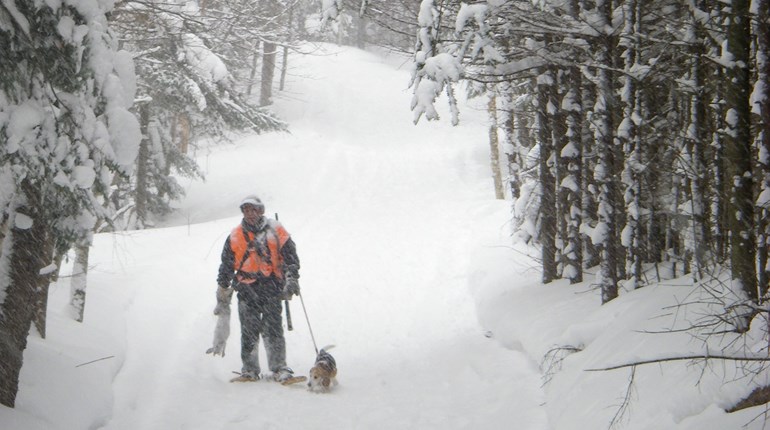
The tactical aspects of long-range shooting are often lost in the online noise that drives the trigger-pulling world these days. For the vast number of long-range shooters, the goal is simply to hit the target. To that end, and just as they have in almost all other aspects of shooting, the new generation of long-range shooters have drifted to smaller cartridges.
Precision Rifle Series (PRS) is the competitive side of long-range shooting, and it’s where most of the current innovation is happening. When I look at a list of the top five PRS cartridges, the 6.5 Creedmoor has the largest bullet, as all others are 6 mms.
Little bullets are great for target shooting, but from a tactical aspect, they are left lacking on impact. It’s more than just energy, which is exponentially tied to velocity. Little bullets going fast can carry a lot of energy, but they lose it quickly on impact.
Nobody knows where this world is headed, but it’s best to be prepared for anything. A tactical long-range rifle may be called on to protect your home and family. In this case, you would be looking for a powerful rifle to stop the bad guys before they get close to you and your loved ones. We’re not talking about a run-of-the-mill home invader, but rather something like an organized terrorist attack on your town or neighborhood. That’s not as far-fetched a scenario as it once might have sounded.
To penetrate cover and/or armor and to break things like vehicles, a bullet needs the trilogy of energy, momentum and mass. Momentum is tied to bullet weight and is a better measure of what to expect on impact. These numbers will be high, as the job here is more than poking holes in bad guys. It takes power to bust up a fuel injector or penetrate light armor.
Cracking engine blocks is mostly for fiction writers, but there are many vulnerable parts in any vehicle that a powerful rifle can damage. The cartridge must also be powerful enough to increase the percentage for a one-shot stop on the bad guy threatening you and your family. You don’t want “adequate,” you want one and done. Overkill is a foolish concept when your life is threatened.
In a defensive situation, I think we need to focus on distances not much farther than 1,000 yards. That might sound like an absurd “defensive” range, but again, if a gaggle of terrorists in the back of a Toyota Hilux is headed to your subdivision, it’s probably a good idea not to let them get too close. That said, going too much past 1,000 yards in a tactical situation creates some problems, including losing the ability for positive target identification.
Most short-action cartridges can probably be ruled out for a lack of horsepower. Many of them are out of steam by 1,000 yards, and often have dropped to subsonic velocities. The newer cartridges like the 6.5 PRC do pretty well, but don’t quite get there. The tried-and-true .308 Win. is subsonic well short of 1,000 yards.
Impact velocity is another important factor. Projectiles are designed to expand at a minimum impact velocity, and although it will vary from bullet to bullet, it’s usually going to be around 1,500 to 2,000 fps or even faster depending on the bullet design. This is important when trying to take out the bad guys, especially where you are likely to only get a single shot.
For the ideal outcome, a bullet should carry around 1,000 ft.-lbs. of energy on impact. I know, I know, handguns have less. But, don’t confuse the terminal needs here. Most handgun fights are at close range and one-shot stops are rare. They also rarely involve breaking stuff or penetrating cover. Handguns are a compromise for when it’s inconvenient to carry a rifle. The two are not the same.
Let’s not get hung up only on energy here, either. Energy is exponentially tied to velocity and, in my never-humble opinion, doing the work needed requires the trilogy of bullet weight (for momentum), bullet diameter and energy. That means that retained velocity is important, but only if it’s mated with a large, heavy bullet. The momentum factor should also be 35 ft.-lbs./second or higher on impact.

The power of the projectile’s impact itself is the forgotten factor, and it’s crucial to any tactical situation. A defensive long-range rifle shooter can stop problems before they become close-range problems, but only with the right tools. That means using a cartridge that can deliver a bullet with lots of power downrange.
The best way to learn about long-range shooting is to actually do it. Theory is fine, but it all changes in the real world. A while back, I traveled to northern Pennsylvania with my friends Jon LaCorte and Jon Allen, the owners of Tract Optics. We spent two days at the Shooters Gauntlet range, owned by Bob Raimo. This impressive shooting facility has several ranges for long-range shooting. The one we shot on has steel targets all the way out to 1,220 yards. We brought truckloads of guns and ammo and made a gallant try to wear those targets out.
Even though the wind was modest, another characteristic of smaller bullets showed up quickly. As we started to extend the range, the smaller cartridges became unpredictable. Hits were achievable out to 800 yards or so, but at 1,200 yards they were not guaranteed. The impacts became inconsistent and unpredictable—and difficult to spot—even if the elevation data was spot on.
Yet, when we were shooting cartridges like .338 Lapua Mag. or .300 Win. Mag., we didn’t see this degree of inconsistency. Sure, the wind blew them off course, but we could predict the point of impact a lot easier.
Serious tactical long-range work is pretty much the domain of long-action or larger rifle cartridges. Let’s take a look at some of the best choices today.
.300 Win. Mag.
This is an old-time, “retro” cartridge. It made its bones shooting targets out to 1,000 yards and held several world records for years. While I own several, the one I built on an AI chassis with a Bartlein barrel is the best for long-range work. In factory loads, both the gun and I prefer Federal Match ammo using 190-grain Sierra MatchKing bullets. Even though the 26.5-inch barrel generates 3,000 fps at the muzzle, the heavy gun and muzzle brake make it easy to shoot.
The .300 Win. Mag. has been proven to be a top hunting cartridge for some of the biggest north American game and it has a long history as a sniper round dating back to Vietnam. Guns and ammo are plentiful and (relatively) inexpensive. It’s still one of the best choices for tactical long range and in recent years there have been developments in bullets that will increase its long-range performance even further. I have shot so many of the Federal 190-grain loads in that rifle that I feel like I am being unfaithful to use something else.
The Federal offering barely misses the 1,000 ft.-lbs.-energy mark at 1,000 yards and has almost 41 ft.-lbs./second of momentum.

7 mm Precision Rifle Cartridge (PRC)
This is the new kid on the block and one of the few sub-30-caliber cartridges that should be considered. It’s the newest of the Hornady PRC line of cartridges which also includes the 6.5 PRC and the .300 PRC.
While I passed on the 6.5 PRC for this article, it’s an amazing cartridge. I have both a hunting rifle and a precision rifle chambered in 6.5 PRC. I have shot several deer with the cartridge, as well as reaching out to very long-range targets. I find the performance to be at the top of the short-action pyramid and technically it just squeezes into our guidelines of energy and momentum. We can’t list every single available cartridge in one short article. But, with the 6.5 PRC, a good shooter could do worse in picking a rifle cartridge for defending their home at long range.
In the 7 mm PRC, the Hornady Match load features a 180-grain EDLM bullet with an amazing G1 BC of .796. Muzzle velocity out of a 24-inch barrel is 2,975 fps. Because of that high BC, it still has 1,455 ft.-lbs. of energy at 1,000 yards and 49 ft.-lbs./second of momentum.
This one is still pretty new, but it’s looking like it might well shuttle in a 7 mm resurgence and rise to the elite level of long-range cartridges with a purpose.
The PRC family is redefining long-range cartridge design, and many serious gun guys think this 7 mm may well be the best of the three. It’s certainly a good choice for any tactical long-range situation.

.300 PRC
The .300 PRC was an early innovator in hard-hitting, long-range cartridge design. The match load uses a heavy-for-caliber 225-grain ELD Match bullet with a G1 BC of .777. With a muzzle velocity of 2,810 fps, this is a serious cartridge. At the muzzle, it has 3,945 ft.-lbs. of energy. At 1,000 yards it’s still carrying 1,548 ft.-lbs. of energy. Momentum is 55.2 ft.-lbs./second. Anything it hits is going to undergo an epiphany.
The downside is that at 3.7 inches in overall length, the cartridge is slightly too long for a lot of existing magazines and rifle actions. That’s going to limit the firearm options for a while.
Most short-action cartridges can probably be ruled out for a lack of horsepower. Many of them are out of steam by 1,000 yards, and often have dropped to subsonic velocities.
.338 Lapua Mag.
There was a time when this was the cutting edge of long-range cartridges. It gained a lot of fame in November 2009, when British sniper Craig Harrison used one to establish a new record for the longest confirmed sniper kill in combat, at a range of 2,707 yards over in Afghanistan. (A record that has since been broken.) As I understand the story, the first hit took out a machine gunner who was shooting at the guys Harrison was protecting. Another enemy took over the machine gun and he killed him. Then with another shot, he broke the machine gun and put it out of action.
This is what I am talking about when I say a tactical long-range bullet has to do some work. Do you think a 6 mm bullet can break a machine gun at 2,707 yards? Don’t strain your brain—it can’t.
The .338 Lapua Mag. is a lot of fun on long-range targets. Where the other cartridges will ring the steel, the Lapua will make it dance. In fact, I have found that it is too rough to use on my steel targets closer than 300 yards. It’s a good idea to give it some distance to burn down a bit before hitting any targets you value.
Although the 300-grain bullet is showing some good stuff, the Lapua made its bones with a 250-grain bullet and I tend to stick with that load. My rifle really likes Federal Match ammo with a 250-grain Sierra MatchKing bullet at a measured 3,063 fps from my rifle. It starts out with 5,209 ft.-lbs. of energy, which is into the elephant-rifle power level. It still has 1,656 ft.-lbs. of energy left at 1,000 yards; all of that energy and 60.3 ft.-lbs./second of momentum concentrated into a 250-grain bullet that’s ready to smash stuff.
That’s why it can break machine guns that are more than a mile and a half away.
Of course, there are other cartridges in the same categories that can do the job pretty well, but these are the most popular and, in some cases, the most proven on the market. If you are serious about your home defense and are thinking of a long-range rifle that can do things beyond just hitting a target, give them a look.




































